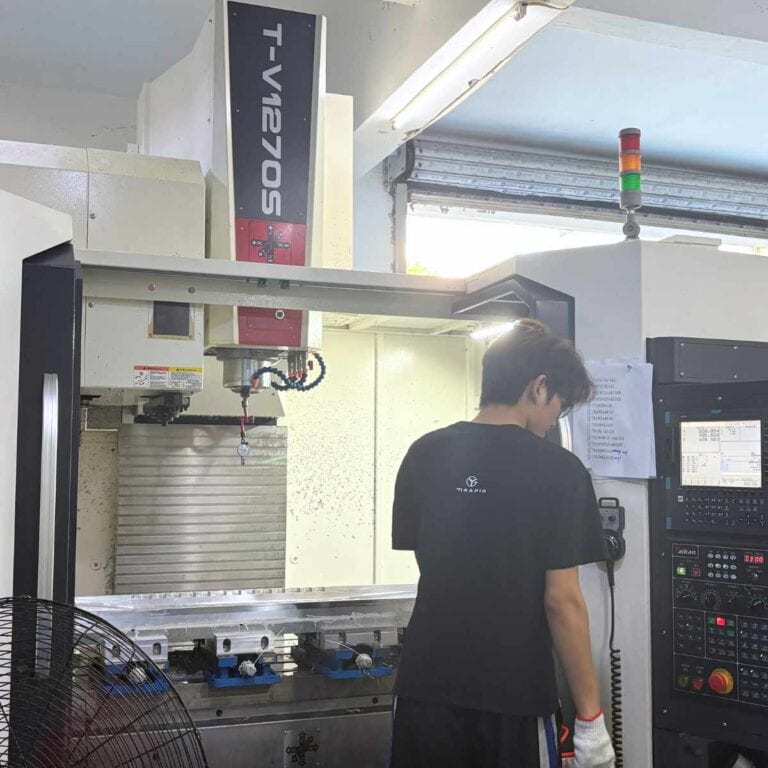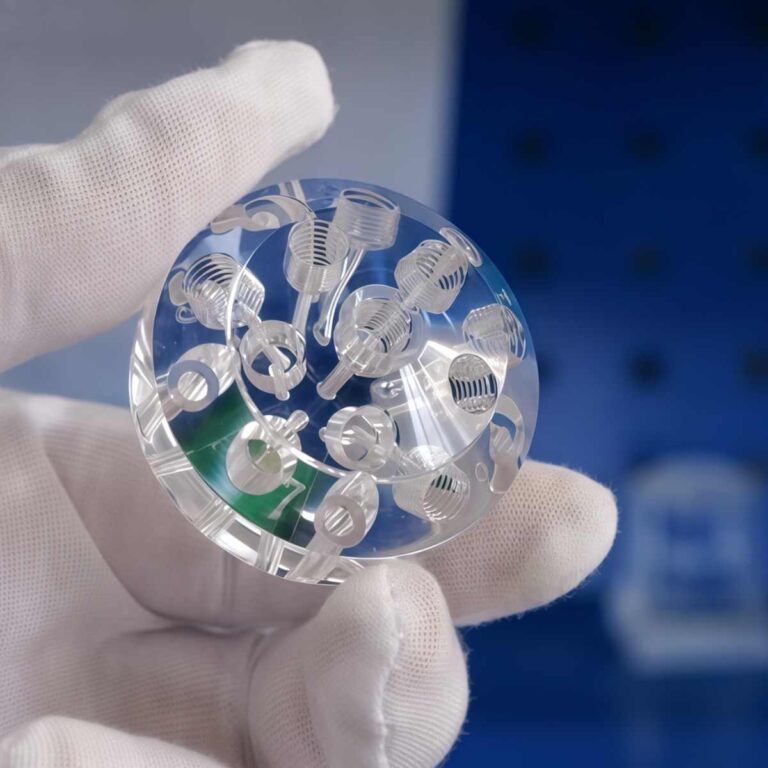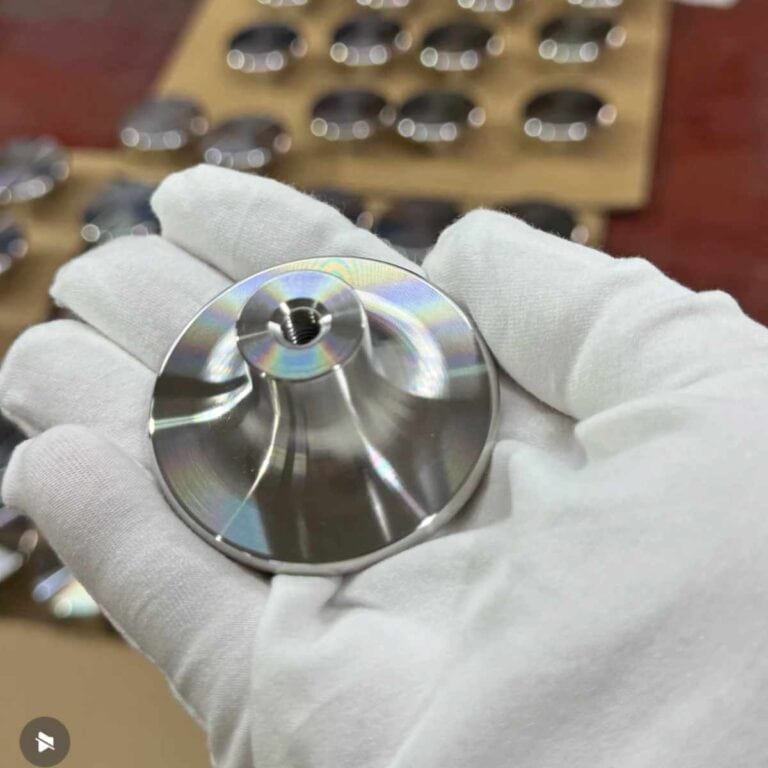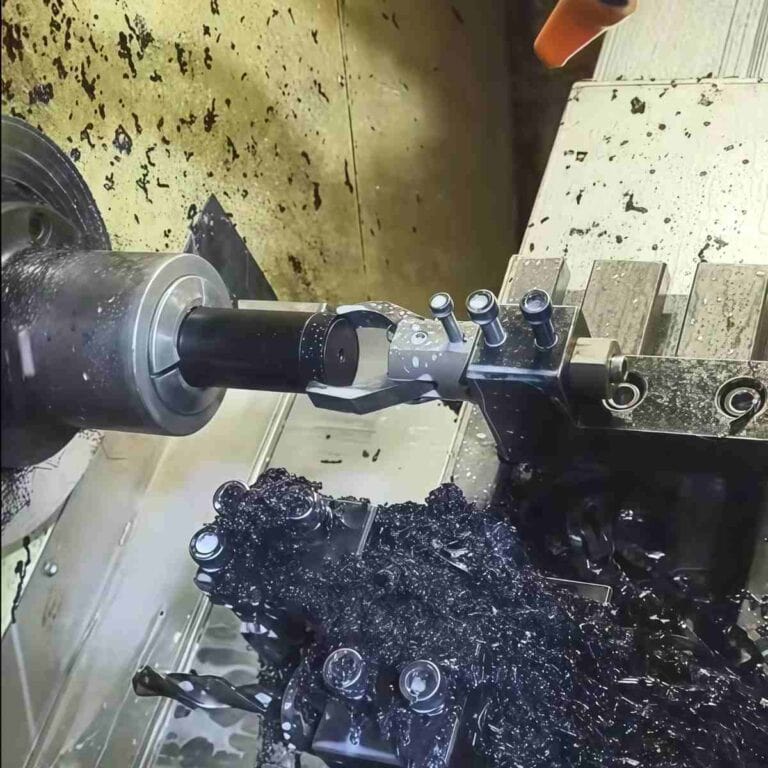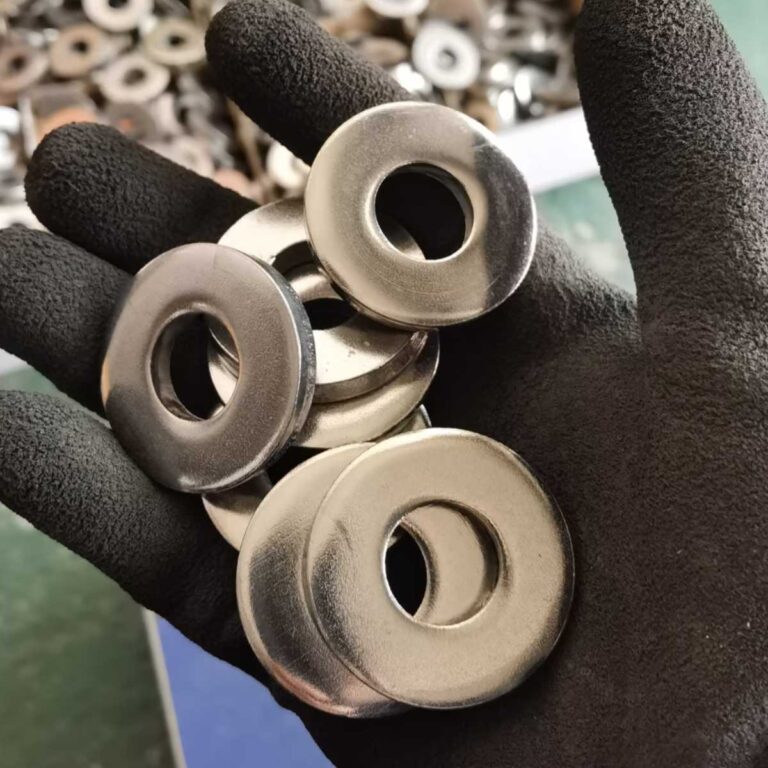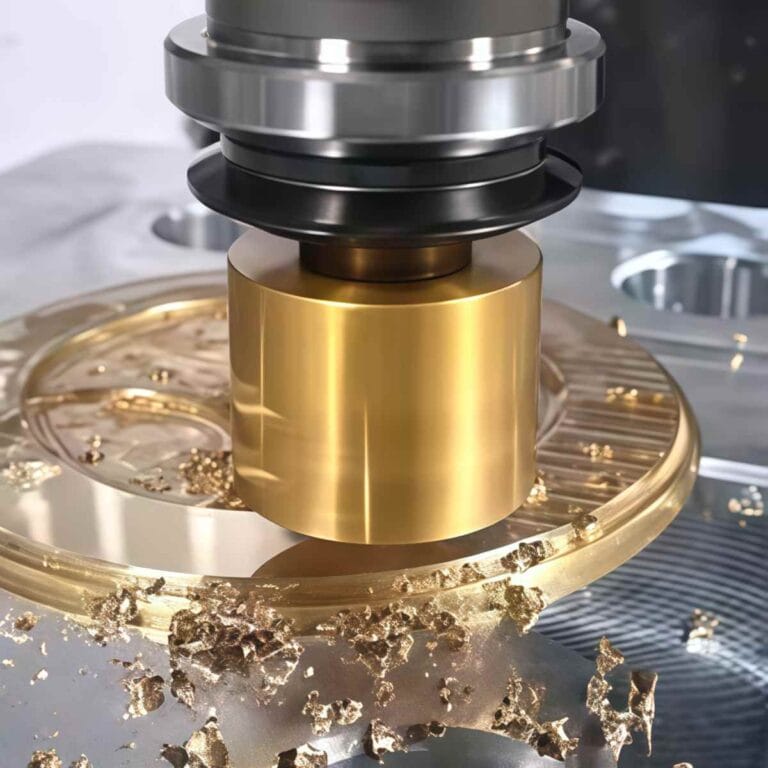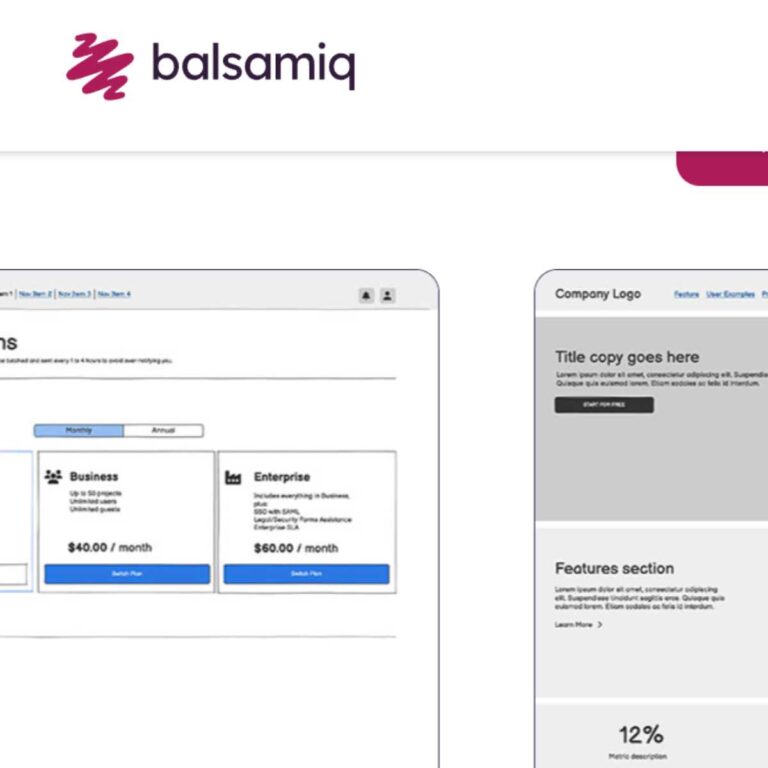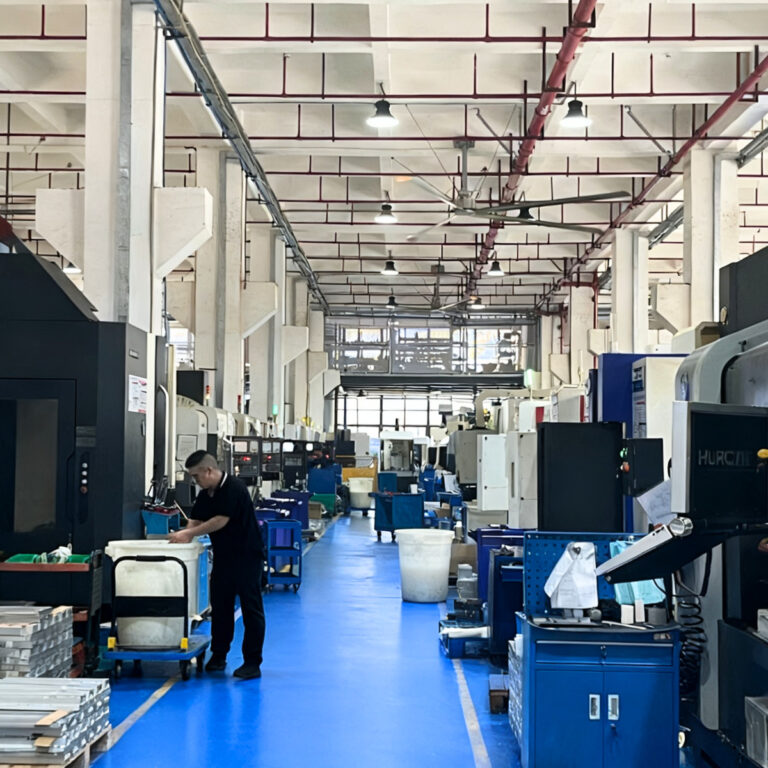Bead Blasting is a precise surface treatment that removes oxides, burrs, and tool marks to achieve a smooth matte finish. It enhances appearance and coating adhesion. This guide covers its principles, process, and applications in CNC manufacturing.
What Is Bead Blasting
Bead blasting is a precise surface finishing process that uses fine glass or ceramic beads to remove oxidation, burrs, and machining marks. It creates a smooth, satin-like texture that enhances appearance and improves coating adhesion. Commonly used in CNC machining, bead blasting delivers both function and visual refinement in one efficient step.
Get 20% offf
Your First Order
How Does Bead Blasting Work
Bead blasting works through high-velocity spherical media impact and micro surface reshaping.
Power Source: Compressed air or centrifugal force propels abrasive beads (glass, ceramic, or plastic) at 50–150 psi.
Working Principle: Instead of cutting, each bead gently “peens” the surface, removing oxidation and minor flaws while forming fine dimples.
Surface Effect: This micro-hammering action diffuses light reflection, creating a uniform satin or matte texture.
What Are The Characteristics Of A Bead Blasted Surface
Surface Texture and Feel
Bead blasting produces a soft, non-reflective surface with a silky touch and uniform texture. It’s the preferred choice for consumer electronics, automotive trims, and medical instruments where appearance and precision matter.
Roughness Range (Ra 0.8–3.2 µm)
Surface roughness depends on bead size and pressure:
Fine glass beads (100–200 mesh): Ra ≈ 0.8–1.2 µm — ideal for decorative finishes.
Medium beads (60–80 mesh): Ra ≈ 1.6–3.2 µm — best for pre-coating or anodizing prep.
Optical and Visual Effects
By adjusting blasting angle and air pressure, surface reflectivity can be reduced by 40–60%, achieving a refined metallic appearance.
For example, bead-blasted aluminum housings eliminate glare and deliver a premium silver-gray tone — a finish widely used in electronics.
Corrosion and Wear Resistance
Bead blasting induces a thin compressive stress layer that strengthens fatigue and corrosion resistance.
The micro-textured surface also enhances coating adhesion by 30–50%.
In our aerospace material testing, bead-blasted aluminum showed a 45% improvement in corrosion resistance in salt spray tests.
What Are The Steps Of The Bead Blasting Process
Bead blasting uses fine glass or ceramic beads to remove oxidation and tool marks, creating a smooth satin finish that improves appearance and coating adhesion. Consistent results rely on precise control of media, pressure, and spray coverage.
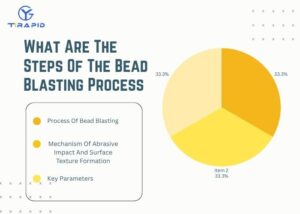
Process Of Bead Blasting
A complete bead blasting process typically includes five stages:
Surface Cleaning
Parts are cleaned with alcohol or a neutral degreaser to remove oil and dust. Any residue can cause uneven reflection or patchy finish.
Equipment Setup
Choose the proper blasting machine (cabinet or automated system) and adjust nozzle size and distance:
Aluminum parts: 100–150 mm
Stainless steel: 150–200 mm
Media Selection
Select media based on surface finish goals:
Glass beads – smooth satin look, Ra ≈ 0.8–1.6 µm
Ceramic beads – stronger texture, Ra ≈ 1.6–3.2 µm
Blasting Operation
Maintain consistent spray movement with overlapping passes. The ideal spray angle is 45°–75°, which ensures even coverage and matte reflection.
Cleaning & Inspection
After blasting, parts are air-blown or ultrasonically cleaned to remove residual media. Surface roughness and visual consistency are then inspected.
Mechanism Of Abrasive Impact And Surface Texture Formation
When glass beads strike the surface at high velocity, they cause microscopic plastic deformation and dimpling effects:
Each impact forms tiny craters that diffuse light and produce a satin appearance.
Overlapping impacts create a uniform microtexture that hides machining lines.
The peening effect improves fatigue resistance by inducing surface compressive stress.
Key Parameters
Air Pressure
Typically set between 0.4–0.8 MPa. Higher pressure can cause graying or distortion, too low leads to incomplete coverage.
Spray Angle:
Optimal between 45°–75°. Smaller angles yield smoother surfaces, larger angles increase roughness.
Duration:
Each section is blasted for 2–5 seconds. Excessive time can damage thin walls or small features.
Automated bead blasting systems use precise timing to maintain uniform results across large production batches.
What Equipment Is Used In Bead Blasting
Bead blasting relies on precise equipment to achieve uniform texture and safe operation. A full setup includes a blasting cabinet, gun, air compressor, and safety system. Each part ensures stable pressure, consistent surface quality, and reliable satin finishes.
Main Equipment
Bead Blasting Cabinet
The blasting cabinet provides a sealed workspace that isolates dust and recycles abrasive media.
Construction: Heavy-duty steel with wear-resistant rubber lining to prevent rebound erosion.
Viewing Window: Anti-fog glass with replaceable protective film for clear visibility.
Lighting & Filtration: LED lighting and closed-loop ventilation systems maintain clarity and dust control.
Blasting Gun
The blasting gun determines spray velocity, coverage, and uniformity.
Nozzle Material: Made of boron or tungsten carbide, lasting up to 3× longer than ceramic nozzles.
Operation: Available in hand-held or foot-pedal types, foot-pedal guns minimize operator fatigue.
Angle Control: Adjustable between 45°–75° to achieve different matte levels and Ra values.
Air Compressor
The air compressor provides kinetic power for blasting.
Pressure Range: Typically 0.4–0.8 MPa — lower pressure for plastics and aluminum, higher for steel or titanium.
Tank Capacity: A minimum of 300–500 L ensures stable airflow and consistent surface results.
Filtration & Drying: Removes moisture and oil vapor to prevent surface whitening or contamination.
Safety Protection System
Operator safety is essential for sustained production.
Protective Gear: Gloves and visors shield against rebounding media.
Dust Collection: Industrial vacuum systems remove up to 99% of airborne particles.
Static & Noise Control: Grounding systems and insulated walls minimize static shocks and sound exposure.
By integrating these components, bead blasting achieves uniform surface aesthetics, improved durability, and reliable operator safety — essential for precision CNC manufacturing.
What Media Are Commonly Used In Bead Blasting
In bead blasting, the media you choose defines the final texture and performance. Each type of bead—glass, ceramic, steel, or plastic—produces unique surface characteristics, from smooth satin finishes to strong matte textures. Selecting the right media ensures aesthetics, durability, and coating adhesion.
Common Bead Blasting Media
Glass Beads
Made from lead-free soda-lime glass, glass beads create a uniform satin finish without affecting color or dimensions. Ideal for aluminum, stainless steel, and brass.
Example: For aluminum housings, using #120 glass beads at 50 PSI achieves Ra 1.0 μm — perfect for anodizing prep.
Aluminum Oxide
Angular and highly abrasive (Mohs 9), suitable for removing oxides, coatings, and burrs. Produces a matte texture with excellent paint adhesion.
Used for molds, hard metals, and surface prep.
Steel Shot
High-density media used for rust removal and surface strengthening, improving fatigue resistance.
Common in automotive and heavy equipment components.
Plastic Beads
Made from acrylic or urea, lightweight and gentle for delicate parts. Removes burrs without changing dimensions.
Ideal for plastic molds and composite parts.
Ceramic Beads
Zirconia-based, harder than glass and more durable. Produces bright, wear-resistant finishes.
Best for titanium, aerospace, and medical parts.
How To Choose the Right Media
Choosing the right bead blasting media is a precise engineering decision that directly impacts surface quality, coating adhesion, and part longevity. Selection should be based on measurable parameters such as grit size, Mohs hardness, Ra roughness range, and material compatibility.
Grit Size (Particle Size Range)
Grit size determines both the aggressiveness of material removal and the smoothness of the final texture.
Fine Media (150–325 mesh) – Creates smooth, satin surfaces with low Ra values between 0.8–1.6 μm, ideal for anodized or cosmetic finishes.
Medium Media (70–150 mesh) – Balances cutting and finishing, achieves Ra 1.6–2.5 μm, commonly used for aluminum or stainless-steel components.
Coarse Media (40–70 mesh) – Produces a visibly matte texture and higher roughness Ra 2.5–3.2 μm, suitable for pre-coating or high-adhesion surfaces.
Engineering Tip: The coarser the grit, the greater the kinetic energy on impact. However, excessive grit size (>60 mesh) can deform thin-walled components or introduce dimensional error of ±0.01 mm.
Hardness (Mohs and HV Scales)
The hardness of blasting media defines how aggressively it interacts with the substrate.
Plastic Beads (Mohs 3 / 150 HV) – Gentle media for composites or polymers, removes contaminants without altering surface geometry.
Glass Beads (Mohs 6 / 500 HV) – Balanced performance for most CNC metals, cleans machining marks while maintaining part color.
Ceramic Beads (Mohs 7.5 / 1100 HV) – High durability and low wear, recommended for titanium, Inconel, and aerospace alloys.
Aluminum Oxide (Mohs 9 / 2000 HV) – The most aggressive, suitable for oxide removal, roughening before coating, or tool refurbishment.
Engineering Tip: For surface-critical aerospace or medical parts, hardness difference between the media and the workpiece should not exceed 3 Mohs points, to prevent micro-cracking or stress concentration.
Surface Roughness (Ra Value Control)
Surface roughness defines how light interacts with the treated surface and determines coating performance.
Ra 0.8–1.6 μm: Achieved using fine glass or ceramic beads for aesthetic and anodized surfaces.
Ra 1.6–2.5 μm: Balanced finish for mechanical components requiring both smoothness and adhesion.
Ra 2.5–3.2 μm: Typical for pre-paint or powder-coating preparation where bonding strength is critical.
Quality Control Tip: Always measure Ra values with a profilometer. Consistent results depend on maintaining stable air pressure (±5 PSI variation) and uniform nozzle distance (150–200 mm).
Material Compatibility
Media selection must match the substrate’s physical and chemical characteristics.
| Workpiece Material | Recommended Media | Target Ra
(μm) |
Application Example |
| Aluminum / Brass | Glass Beads | 1.0–1.6 | Cosmetic finish before anodizing |
| Stainless Steel | Aluminum Oxide / Glass Beads | 1.6–2.5 | Tool mark removal, pre-coating |
| Titanium / Superalloys | Ceramic Beads | 1.2–1.8 | Aerospace structural parts |
| Steel / Iron | Steel Shot / Aluminum Oxide | 2.5–3.2 | Rust removal, fatigue strengthening |
| Plastics / Resin | Plastic Beads | 0.8–1.6 | Gentle cleaning, burr removal |
Optimization Tip:
In mixed-metal assemblies, always select non-contaminating media such as glass or ceramic beads to prevent galvanic corrosion.
How Bead Blasting Differs From Other Surface Finishes
Bead blasting achieves a satin finish without deforming part geometry. Using fine glass or ceramic beads under controlled pressure, it gently removes oxidation and tool marks with minimal material loss. Compared with sandblasting, anodizing, or polishing, it offers balanced precision, aesthetics, and cost-efficiency.
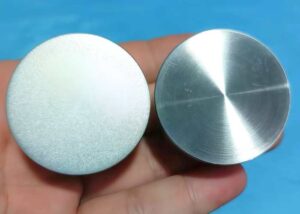
Core Differences
Abrasive Type
Bead blasting uses spherical media (glass or ceramic beads), while traditional sandblasting relies on angular grit (aluminum oxide or silica). The rounded impact of bead media “peens” the surface gently, creating a satin texture without cutting material.
Glass Bead Hardness: Mohs 6, Typical Size: 50–200 µm.
Aluminum Oxide Hardness: Mohs 9, Size: 60–120 µm.
Impact Energy and Strength
Bead blasting exerts only 40–60% of the impact energy of conventional sandblasting, preserving part geometry within ±0.01 mm tolerance.
Typical roughness values:
Bead Blasting: Ra 0.8–1.6 µm
Sandblasting: Ra 2.5–3.5 µm
Surface Appearance and Reflectivity
Bead blasting produces uniform satin or matte finishes with soft reflection.
Sandblasting creates a rougher, more industrial look for strong coating adhesion.
Polishing yields mirror finishes but requires higher labor and cost.
Comparison Of Surface Treatment Processes
| Process | Principle | Typical Ra
(µm) |
Visual Effect | Best Materials | Primary Applications |
| Bead Blasting | Spherical media impact for soft satin finish | 0.8–1.6 | Uniform matte look without cut marks | Aluminum, Stainless Steel, Titanium | Decorative finish, pre-anodizing prep |
| Sandblasting | Angular grit abrasion for strong adhesion | 2.5–3.5 | Rough matte texture | Steel, Cast Iron | Rust removal, coating preparation |
| Anodizing | Electrochemical oxidation layer | 0.4–0.8 | Colored, corrosion-resistant surface | Aluminum Alloys | Corrosion protection, cosmetic finish |
| Polishing | Mechanical abrasion for mirror surface | 0.05–0.4 | High-gloss mirror effect | Brass, Stainless Steel | Decorative and reflective parts |
When To Choose Bead Blasting
For aesthetic parts requiring precision: Ideal for aluminum or titanium CNC housings demanding a Ra ≈ 1.0 µm and sharp edge preservation.
For pre-coating or pre-anodizing preparation: Bead blasting increases surface energy without altering dimensions, improving paint or coating adhesion by 20–30%.
For industries requiring non-contamination: Medical, aerospace, and electronics sectors prefer non-metallic media to prevent particle embedding or galvanic corrosion.
For thin-walled or multi-material components: Low-pressure bead blasting (2.5–3 bar) prevents distortion in components < 1.5 mm thick, ensuring uniform texture and color.
What Are The Advantages And Limitations Of Bead blasting
Bead blasting refines CNC parts by removing oxidation and tool marks while enhancing appearance and coating adhesion. Though gentle and precise, it removes little material, requires low pressure for thin parts, and demands good dust control.
Advantages
Smooth and Consistent Surface
Bead blasting delivers a fine satin finish with Ra 0.8–1.6 μm, ensuring a uniform, non-directional texture. Unlike mechanical polishing, it leaves no swirl marks and maintains tight tolerances, ideal for cosmetic or precision parts.
Effective Tool Mark Removal
CNC machining often leaves visible tool paths and burrs. Bead blasting gently re-textures the surface, removing machining marks without cutting material.
Under equal pressure, glass bead blasting improves surface uniformity by 20% over aluminum oxide blasting while preserving dimensional accuracy.
Enhanced Coating Adhesion
By slightly increasing surface roughness, bead blasting boosts coating or anodizing adhesion. Surfaces with Ra 1.2–1.8 μm show up to 25–30% better bonding strength for anodized and powder-coated finishes, making it ideal as a pre-treatment step.
Limitations
Limited Material Removal
Bead blasting is a non-cutting process, material removal typically stays below 5 μm. It’s unsuitable for fixing deep scratches or corrosion.
For defects exceeding 0.05 mm, pre-grinding or coarse-grit blasting should precede fine bead finishing.
Dust and Cross-Contamination Risks
Poor cabinet sealing or worn filters can lead to dust buildup or metal contamination—especially when blasting aluminum and steel in the same chamber.
Use dedicated media bins, HEPA filtration, and replace media regularly to maintain purity.
Low Pressure for Thin or Complex Parts
Thin-walled components (< 1.5 mm) require 2.0–2.5 bar to prevent distortion.
How To Achieve The Best Bead Blasting Results
Achieving a consistent satin finish requires choosing the right media and tightly controlling pressure, bead size, and spray angle. These factors directly affect roughness, color uniformity, and coating adhesion. From my CNC finishing experience, precise parameter control is essential for reducing rework and ensuring consistent batch quality.
Media And Grit Selection
Different media types and grit sizes determine Ra values, gloss levels, and cutting behavior.
Glass Beads 100–150: For aluminum, Ra 1.0–1.6 μm, ideal before anodizing.
Ceramic Beads 200–300: For titanium and superalloys, producing bright and refined surfaces.
Aluminum Oxide 80–120 grit: Stronger cutting force, higher roughness.
For medical-grade aluminum enclosures, I often use 120 glass beads at 50 PSI, producing a uniform satin finish without altering color.
Pre-Blast Cleaning
Residual oils and machining fluids cause inconsistent blasting results.
Recommended cleaning: IPA or alkaline degreasers
Oil contamination leads to streaks, uneven Ra, and patchy matte effects
In one project, insufficient pre-cleaning resulted in visible cloud patterns and required a complete re-blast.
Maintain A Stable Stand-Off Distance
Stable distance ensures consistent impact energy.
Optimal distance: 100–150 mm
Too close: overly rough surface
Too far: insufficient matte texture
I typically set fixed locator points inside the cabinet to help operators maintain consistency.
Surface Roughness And Sample Verification
To ensure batch repeatability, I use:
Ra sample plates (0.8 / 1.2 / 1.6 μm)
Profilometer inspection
Customers often judge bead blasting quality heavily by surface roughness data.
Masking Critical Areas
Precision surfaces must be protected:
O-ring grooves
Sealing surfaces
Threads
Tight tolerance mating features (e.g., H7 holes)
Common masking tools include high-temperature tapes, rubber plugs, and metal shields.
Pressure & Angle Control
Pressure determines bead impact energy:
Glass beads: 40–60 PSI
Ceramic beads: 50–70 PSI
Spray angle: 70–90°
Excessive pressure causes premature bead fracture and contaminates the finish.
Regular Media Replacement
Beads gradually break down during use.
Glass beads last 25–35 cycles
Ceramic beads last 50+ cycles
Replace media when gloss drops or Ra deviation exceeds ±0.2 μm
Keeping a media replacement log is essential for consistent quality.
What Industries Are Bead blasting Commonly Used
Bead blasting is widely used in aerospace, automotive, medical, electronics, and consumer industries to remove oxidation, refine surfaces, and enhance coating adhesion.
| Industry | Purpose of Bead Blasting | Typical Components | Surface Requirements / Parameters | Advantages of Bead Blasting |
| Aerospace | Surface uniformity, micro-defect removal, fatigue improvement | Engine blades, titanium brackets, aircraft structural parts | Ra 0.8–1.6 μm | Maintains dimensions, improves wear resistance and coating adhesion |
| Automotive | Oxide removal, surface strengthening, aesthetic improvement | Aluminum housings, suspension parts, brake components | Ra 1.2–2.5 μm | Fatigue strength +10–20%, smoother and more consistent appearance |
| Medical Devices | Cleaning, deburring, surface refinement | Surgical tools, titanium implants, stainless steel parts | Zero contamination residue | Produces clean, non-directional satin finishes suitable for medical use |
| Electronics & Semiconductor | High-end matte finish, tool mark removal | Aluminum phone housings, laptop chassis, heat sinks | Ra 0.8–1.6 μm | Enhances anodizing color uniformity and prevents glare |
| Consumer Electronics & Appliances | Improve touch/feel and surface texture | Camera bodies, home appliance enclosures | High visual consistency | Creates premium satin textures and uniform appearance |
| General Manufacturing | Weld cleaning, deburring, pretreatment | Machined parts, molds, castings | Depends on process | Enhances paint/plating adhesion and overall surface quality |
| Marine & Energy | Rust removal, corrosion-prep | Stainless parts, flanges, pump housings | Sa 2.0–2.5 | Improves corrosion resistance and durability |
FAQs
Does Bead Blasting Affect Dimensional Accuracy?
Bead blasting has minimal impact on dimensional accuracy because it removes only a microscopic layer of material—typically less than 0.01–0.03 mm. In my experience, even precision CNC parts with ±0.02 mm tolerances remain stable when pressure is kept at 40–60 PSI. Only thin walls or fragile features require masking or lower pressure to prevent distortion.
Does Bead Blasting Remove Metal?
Yes, but the amount is extremely small. Bead blasting performs micro-level abrasion rather than cutting, removing only surface oxidation and tool marks. Material loss is usually below 0.5–2 μm depending on bead size and pressure. I often use #120 glass beads for aluminum parts, which produce a satin finish without measurable dimensional change.
Is Bead Blasting Suitable For Aluminum And Plastic Parts?
Bead blasting is highly suitable for aluminum and can also be used on plastics when low pressure is applied. Aluminum achieves a uniform Ra 1.0–2.0 μm satin finish with glass beads, while plastics require softer media such as acrylic beads and pressures under 30 PSI. I often blast ABS and PC parts for texture enhancement without deformation.
Can Bead Blasting Remove Paint?
Yes. Bead blasting can strip light to medium coatings, including paint, oxidation, and thin plating layers. With coarse beads (#60–80) and 60–80 PSI pressure, I typically remove paint efficiently without damaging the substrate. For thicker industrial coatings, a more aggressive media—such as aluminum oxide—may be required.
Is The Cost Of Bead Blasting High?
Bead blasting is cost-effective compared with polishing or chemical finishing. For CNC parts, it usually adds only 1–3 USD per piece, depending on size and complexity. Because glass beads can be reused 20–30 times, the overall processing cost stays low. I often recommend it as the best balance between appearance, adhesion, and cost.
Conclusion
Bead blasting is a surface treatment method that combines aesthetics and functionality, giving metal, plastic, or composite parts a better texture and adhesion. In CNC machining, sandblasting is a key step towards a “finished-product appearance.” By correctly selecting the medium, controlling the parameters, and ensuring proper protection, an ideal satin finish can be consistently achieved. If you have any needs regarding bead blasting surface treatment processes or other questions, please let us know, we look forward to contacting you!

